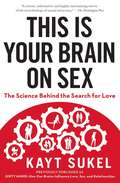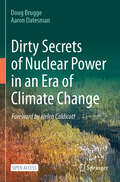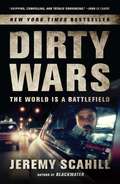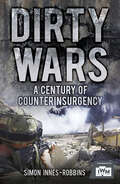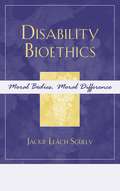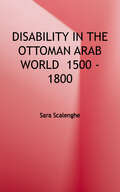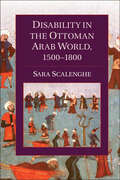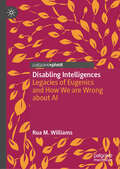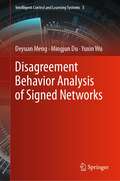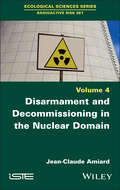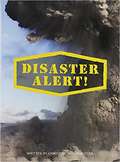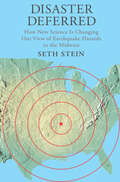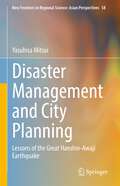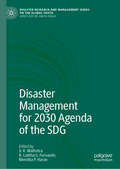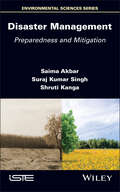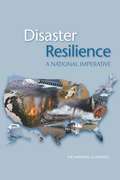- Table View
- List View
Dirty Minds: How Our Brains Influence Love, Sex, and Relationships
by Kayt SukelPhilosophers, theologians, artists, and boy bands have waxed poetic about the nature of love for centuries. But what does the brain have to say about the way we carry our hearts? In the wake of a divorce, science writer and single mother Kayt Sukel made herself a guinea pig in the labs of some unusual love experts to find out. In each chapter of this edgy romp through the romantic brain, Sukel looks at a different aspect of love above the belt. What in your brain makes you love someone--or simply lust after them? (And is there really a difference?) Why do good girls like bad boys? Is monogamy practical? How thin is that line between love and hate? Do mothers have a stronger bond with their children than their fathers do? How do our childhood experiences affect our emotional control? Should you be taking an oxytocin supplement to improve your luck in love? Who is most at risk for love addiction? In her search for truth, Sukel also has an fMRI during orgasm, ponders a cure for heartbreak, and samples a pheromone spray called Boarmate. As science allows us a more focused examination on the intricate dance between the brain and our environments, we can use it to shed new light on humanity's oldest question: What is love and why does it torture, delight, and transform us so? Fiercely honest and wonderfully funny, Sukel can offer no simple solutions for the curveballs love throws our way. But after reading this gimlet-eyed look at love, sex, and the brain, you'll never look at romance the same way again.
Dirty Rats?
by Darrin LundeNobody likes a rat. And we're not talking about a snitch here. We're talking about those disgusting bald-tailed rodents that scurry around alleys and in the subway. But, hold on . . . are rats really so bad? There are hundreds of rat species all around the world that defy common stereotypes. Rats help predators survive, allow plants to spread their seeds, and even contribute to medical research that helps humans stay healthy. Simple, clear text introduces many of the rats that crawl on the earth today, where they live, what they eat, and how they survive. Next time you see a rat, take a second look.
Dirty Secrets of Nuclear Power in an Era of Climate Change
by Doug Brugge Aaron DatesmanThis open access book provides a review of the serious limitations and drawbacks to nuclear power, and clearly conveys why nuclear power is a less than desirable option in terms of addressing climate change. It uses accessible and engaging language to help bring an understanding of the issues with nuclear power to a broader sector of the public, with the intention of appealing to non-scientists seeking knowledge on the disadvantages of nuclear power as a solution for climate change. The argument is made that while superficially appealing, nuclear power is too costly, fragile, and slow to implement, compared to alternative options such as wind and solar. “As this book shows, to nowadays hold on to Nuclear Energy, a risky and extremely expensive method of create power, just does not make sense any longer.” -- Prof. (em.) Andreas Nidecker, MD, retired academic radiologist, Basel, Switzerland “Datesman and Brugge present evidence that nuclear power is an insecure and unsecureable technology, inherently incompatible with humanity and democracy; it fuels nuclear weapons technology and possession; choosing it would damage our chances at mitigating the climate crisis.” -- Cindy Folkers, MS, Radiation & Health Specialist, Beyond Nuclear “Although the government, industrial, and scientific nexus say it is safe.…I can only think of one word in Navajo "Ina'adlo'" meaning manipulation by the power that be to say it is safe. My Navajo people are dying from the uranium exposure on their health and environment. Great account of information on studies that have taken place around the world to say uranium is not good.” – Esther Yazzie, Navajo Interpreter and knowledge holder on Navajo issues. “At a time when there is a call to triple the growth of nuclear power, Datesman and Brugge provide a timely and thorough examination of the dark-side of “romancing” the atom. With solid technical astuteness, they cover a wide field littered with unsolved and dangerous problems ranging from the poisoning of people and the environment to the failed economics, to the spread of nuclear weapons ….they point out how science and public trust have been corrupted by the lure of unfettered nuclear growth.” –Robert Alvarez, Associate Fellow at the Institute for Policy Studies in Washington, D.C.
Dirty Wars
by Jeremy ScahillThis enhanced edition for Apple tablets features over thirty images, including film stills from the Oscar-nominated documentary Dirty Wars, as well as exclusive photographs of Scahill’s reporting in Yemen and Somalia. This edition also features interactive color maps, as well as seven short videos that include the film trailer, clips from the film, and interviews with Scahill. In the video interviews, Scahill shares his insights on the history of drones, President Obama’s hawkish foreign policies, and the killing of Anwar al-Awlaki. In Dirty Wars, Jeremy Scahill, author of the New York Times best-seller Blackwater, takes us inside America’s new covert wars. The foot soldiers in these battles operate globally and inside the United States with orders from the White House to do whatever is necessary to hunt down, capture or kill individuals designated by the president as enemies. Drawn from the ranks of the Navy SEALs, Delta Force, former Blackwater and other private security contractors, the CIA’s Special Activities Division and the Joint Special Operations Command ( JSOC), these elite soldiers operate worldwide, with thousands of secret commandos working in more than one hundred countries. Funded through #147;black budgets,” Special Operations Forces conduct missions in denied areas, engage in targeted killings, snatch and grab individuals and direct drone, AC-130 and cruise missile strikes. While the Bush administration deployed these ghost militias, President Barack Obama has expanded their operations and given them new scope and legitimacy. Dirty Wars follows the consequences of the declaration that #147;the world is a battlefield,” as Scahill uncovers the most important foreign policy story of our time. From Afghanistan to Yemen, Somalia and beyond, Scahill reports from the frontlines in this high-stakes investigation and explores the depths of America’s global killing machine. He goes beneath the surface of these covert wars, conducted in the shadows, outside the range of the press, without effective congressional oversight or public debate. And, based on unprecedented access, Scahill tells the chilling story of an American citizen marked for assassination by his own government. As US leaders draw the country deeper into conflicts across the globe, setting the world stage for enormous destabilization and blowback, Americans are not only at greater risk#151;we are changing as a nation. Scahill unmasks the shadow warriors who prosecute these secret wars and puts a human face on the casualties of unaccountable violence that is now official policy: victims of night raids, secret prisons, cruise missile attacks and drone strikes, and whole classes of people branded as #147;suspected militants. ” Through his brave reporting, Scahill exposes the true nature of the dirty wars the United States government struggles to keep hidden.
Dirty Wars
by Jeremy ScahillFrom the International Bestselling author of Blackwater comes the story of AmericaOCOs global killing machine. "
Dirty Wars: A Century of Counterinsurgency
by Simon Innes-Robbins‘Who is the enemy?’ This is the question most asked in modern warfare; gone are the set-piece conventional battles of the past. Once seen as secondary to more traditional conflicts, irregular warfare (as modified and refashioned since the 1990s) now presents a major challenge to the state and the bureaucratic institutions which have dominated the twentieth century, and to the politicians and civil servants who formulate policy. Twenty-first-century conflict is dominated by counterinsurgency operations, where the enemy is almost indistinguishable from innocent civilians. Battles are gunfights in jungles, deserts and streets; winning ‘hearts and minds’ is as important as holding territory. From struggles in South Africa, the Philippines and Ireland to operations in Iraq, Afghanistan and Chechnya, this book covers the strategy and doctrine of counterinsurgency, and the factors which ensure whether such operations are successful or not. Recent ignorance of central principles and the emergence of social media, which has shifted the odds in favour of the insurgent, have too often resulted in failure, leaving governments and their security forces embedded in a hostile population, immersed in costly and dangerous nation-building.
Dirty Wars: The World is a Battlefield
by Jeremy ScahillIn Dirty Wars, Jeremy Scahill, author of the New York Times best-seller Blackwater, takes us inside America’s new covert wars. The foot soldiers in these battles operate globally and inside the United States with orders from the White House to do whatever is necessary to hunt down, capture or kill individuals designated by the president as enemies. Drawn from the ranks of the Navy SEALs, Delta Force, former Blackwater and other private security contractors, the CIA’s Special Activities Division and the Joint Special Operations Command ( JSOC), these elite soldiers operate worldwide, with thousands of secret commandos working in more than one hundred countries. Funded through “black budgets,” Special Operations Forces conduct missions in denied areas, engage in targeted killings, snatch and grab individuals and direct drone, AC-130 and cruise missile strikes. While the Bush administration deployed these ghost militias, President Barack Obama has expanded their operations and given them new scope and legitimacy. Dirty Wars follows the consequences of the declaration that “the world is a battlefield,” as Scahill uncovers the most important foreign policy story of our time. From Afghanistan to Yemen, Somalia and beyond, Scahill reports from the frontlines in this high-stakes investigation and explores the depths of America’s global killing machine. He goes beneath the surface of these covert wars, conducted in the shadows, outside the range of the press, without effective congressional oversight or public debate. And, based on unprecedented access, Scahill tells the chilling story of an American citizen marked for assassination by his own government. As US leaders draw the country deeper into conflicts across the globe, setting the world stage for enormous destabilization and blowback, Americans are not only at greater risk—we are changing as a nation. Scahill unmasks the shadow warriors who prosecute these secret wars and puts a human face on the casualties of unaccountable violence that is now official policy: victims of night raids, secret prisons, cruise missile attacks and drone strikes, and whole classes of people branded as “suspected militants.” Through his brave reporting, Scahill exposes the true nature of the dirty wars the United States government struggles to keep hidden.
Disability Bioethics: Moral Bodies, Moral Difference
by Jackie Leach ScullyJackie Leach Scully argues that bioethics cannot avoid the task of considering the moral meaning of disability in humans--beyond simply regulating reproductive choices or new areas of biomedical research. By focusing on the experiential and empirical reality of impairment and drawing on recent work in disability studies, Scully brings new attention to complex ethical questions surrounding disability. Impairment is variously considered as a set of social relations and practices, as experienced embodiment, as an emancipatory movement, and as a biomedical phenomenon. In this way, disability is joined to the general late-twentieth-century trend of attending to difference as a significant and central axis of subjectivity and social life.
Disability in the Ottoman Arab World, 1500-1800 (Cambridge Studies in Islamic Civilization Ser.)
by Sara ScalenghePhysical, sensory, and mental impairments can influence an individual's status in society as much as the more familiar categories of gender, class, religion, race, and ethnicity. This was especially true of the early modern Arab Ottoman world, where being judged able or disabled impacted every aspect of a person's life, including performance of religious ritual, marriage, job opportunities, and the ability to buy and sell property. Sara Scalenghe's book is the first on the history of both physical and mental disabilities in the Middle East and North Africa, and the first to examine disability in the non-Western world before the nineteenth century. Unlike previous scholarly works that examine disability as discussed in religious texts such as the Qur'an and the Hadith, this study focuses on representations and classifications of disability and impairment across a wide range of biographical, legal, medical, and divinatory primary sources.
Disability in the Ottoman Arab World, 1500-1800 (Cambridge Studies in Islamic Civilization)
by Sara ScalenghePhysical, sensory, and mental impairments can influence an individual's status in society as much as the more familiar categories of gender, class, religion, race, and ethnicity. This was especially true of the early modern Arab Ottoman world, where being judged able or disabled impacted every aspect of a person's life, including performance of religious ritual, marriage, job opportunities, and the ability to buy and sell property. Sara Scalenghe's book is the first on the history of both physical and mental disabilities in the Middle East and North Africa, and the first to examine disability in the non-Western world before the nineteenth century. Unlike previous scholarly works that examine disability as discussed in religious texts such as the Qur'an and the Hadith, this study focuses on representations and classifications of disability and impairment across a wide range of biographical, legal, medical, and divinatory primary sources.
Disabled Upon Arrival: Eugenics, Immigration, And The Construction Of Race And Disability
by Jay Timothy DolmageIn North America, immigration has never been about immigration. That was true in the early twentieth century when anti-immigrant rhetoric led to draconian crackdowns on the movement of bodies, and it is true today as new measures seek to construct migrants as dangerous and undesirable. This premise forms the crux of Jay Timothy Dolmage’s new book Disabled Upon Arrival: Eugenics, Immigration, and the Construction of Race and Disability, a compelling examination of the spaces, technologies, and discourses of immigration restriction during the peak period of North American immigration in the early twentieth century. Through careful archival research and consideration of the larger ideologies of racialization and xenophobia, Disabled Upon Arrival links anti-immigration rhetoric to eugenics—the flawed “science” of controlling human population based on racist and ableist ideas about bodily values. Dolmage casts an enlightening perspective on immigration restriction, showing how eugenic ideas about the value of bodies have never really gone away and revealing how such ideas and attitudes continue to cast groups and individuals as disabled upon arrival.
Disabling Intelligences: Legacies of Eugenics and How We are Wrong about AI
by Rua M. WilliamsThis book discusses the influences of eugenics on the AI industry and the impacts of AI opportunism on disabled people. Why are the negative consequences of so-called AI so consistently directed at disabled and racialized people? Disabling Intelligences answers this question by detailing the ongoing effects of the eugenicist mindset on our corporate ventures and our interpersonal relationships. It offers an accessible guide to the various meanings, methods, and impacts of AI, and provides a clear framework for classifying, categorizing, evaluating, and critiquing AI projects. Bridging the gap between STS and critical disability studies, the author centers disabled experiences to present a novel framework that helps readers transform their understandings of citizenship, consumerism, social movements, journalism, engineering, research, and scholarship. An ideal reading for academics at all levels interested in AI technologies across the social sciences and humanities, as well as engineering and computer science, this groundbreaking short monograph challenges our understanding and assumptions about technology, encompassing the history of AI and disability from popular culture to real-life case-studies. Readers will come away from this text equipped with a clarity of perception and a toolkit for evaluating and resisting metaeugenics in technology.
Disagreement Behavior Analysis of Signed Networks (Intelligent Control and Learning Systems #5)
by Deyuan Meng Mingjun Du Yuxin WuThis book investigates the disagreement behavior analysis problems for signed networks in the presence of both cooperative and antagonistic interactions among agents. Owing to the existing antagonistic interactions, signed networks exhibit a variety of disagreement behaviors subject to different topology conditions, especially in comparison with commonly considered unsigned networks involving only cooperative interactions among agents. Since signed networks are generally adopted to describe the dynamics of some practical network systems, they have attracted much attention in many areas, such as biology, sociology, economics, and politics. By focusing on agents with the first-order linear dynamics, the book establishes the systematic behavior analysis frameworks for signed networks, under which diverse disagreement behaviors have been disclosed, including both convergence and fluctuation behaviors, regardless of static or dynamic network topologies. In particular, a class of dynamic signed networks has been introduced, together with the associated dynamic distributed controller design and disagreement behavior analysis of agents. This book is intended for undergraduate and graduate students, engineers, and researchers who are interested in control of network systems, multi-agent systems, social networks, and so on.
Disarmament and Decommissioning in the Nuclear Domain
by Jean-Claude AmiardFollowing the acquisition of the atomic bomb by five states, the United Nations began drafting several treaties to limit nuclear proliferation. These efforts failed, as four more states also acquired nuclear weapons. In a similar vein, an attempt to limit atomic weapons - primarily within the two superpowers - was initiated.While the number of weapons has decreased, the new bombs now being manufactured are more powerful and more precise, negating any reduction in numbers. In the field of civil nuclear use, all nuclear facilities (reactors, factories, etc.) have a limited lifespan. Once a plant is permanently shut down, these facilities must be decommissioned and dismantled.These operations are difficult, time-consuming and costly. In addition, decommissioning generates large volumes of radioactive waste of various categories, including long-lived and high-activity waste. Risks to the environment and to health are not negligible during decommissioning. The International Atomic Energy Agency (IAEA) and the Nuclear Energy Agency (NEA) of the Organisation for Economic Co-operation and Development (OECD) have produced numerous publications with recommendations. Each state has its own decommissioning strategy (immediate or delayed) and final plan for the site - whether it be returning it to greenfield status or obtaining a nuclear site license with centuries-long monitoring.
Disaster Deferred: A New View of Earthquake Hazards in the New Madrid Seismic Zone
by Seth SteinIn the winter of 1811-12, a series of large earthquakes in the New Madrid seismic zone-often incorrectly described as the biggest ever to hit the United States-shook the Midwest. Today the federal government ranks the hazard in the Midwest as high as California's and is pressuring communities to undertake expensive preparations for disaster. Coinciding with the two-hundredth anniversary of the New Madrid earthquakes, Disaster Deferred revisits these earthquakes, the legends that have grown around them, and the predictions of doom that have followed in their wake. Seth Stein clearly explains the techniques seismologists use to study Midwestern quakes and estimate their danger. Detailing how limited scientific knowledge, bureaucratic instincts, and the media's love of a good story have exaggerated these hazards, Stein calmly debunks the hype surrounding such predictions and encourages the formulation of more sensible, less costly policy. Powered by insider knowledge and an engaging style, Disaster Deferred shows how new geological ideas and data, including those from the Global Positioning System, are painting a very different-and much less frightening-picture of the future.
Disaster Deferred: How New Science Is Changing Our View of Earthquake Hazards in the Midwest
by Seth SteinA geologist takes readers inside contemporary earthquake research to offer a new account of the Midwest&’s legendary New Madrid fault—&“an exceptional read&” (Choice). In the winter of 1811-12, a series of large earthquakes in the New Madrid seismic zone shook the Midwest. These historic geological events are often incorrectly described as the biggest ever to hit the United States. Today the federal government ranks the earthquake hazard in the Midwest as high as California's and is pressuring communities to undertake expensive preparations for disaster. In Disaster Deferred, geologist Seth Stein revisits these earthquakes, the legends that have grown around them, and the predictions of doom that have followed in their wake. He details how limited scientific knowledge, bureaucratic instincts, and the media's love of a good story have exaggerated these hazards. Debunking the hype, Stein explains how contemporary seismological techniques—including the use of GPS—painting a very different-and much less frightening-picture of the future. Using new geological ideas and data, he calls for a more sensible, less costly policy. &“An essential book for policy makers, economists, and notably educators.&”—Choice
Disaster Management and City Planning: Lessons of the Great Hanshin-Awaji Earthquake (New Frontiers in Regional Science: Asian Perspectives #58)
by Yasuhisa MitsuiThis book first provides a comprehensive guideline for future disaster-resistant city planning in large cities in disaster-prone countries such as Japan. It is a compilation of knowledge and know-how obtained through the author’s work in the national government for one and half years in the Earthquake Reconstruction Headquarters, right after the Great Hanshin-Awaji Earthquake on 17 January 1995. The author has carefully examined the various ad hoc measures taken just after the earthquake, which were criticized because they did not work as well as expected. Additionally, he has examined the later revisions in disaster and risk management systems made at the levels of local and national governments through experience in the Hanshin-Awaji Earthquake, to which the author had long been committed. The author argues that the rescue activities, rehabilitation, and reconstruction plans for disaster countermeasures implemented once a disaster has occurred and the city planning established in ordinary times should be extremely tightly connected with each other. City planning that subsumes rescue activities, rehabilitation, and reconstruction plans against what ought to have happened would critically improve the capability of crisis management and, consequently, protect life and property once a disaster has occurred. Such city planning eventually creates disaster-resistant cities. This book assumes readers to be graduate students who study city planning. It is also beneficial for practitioners and policy makers who are in charge of the construction of disaster-resistant cities at the national and local levels of governments, especially in disaster-prone countries.
Disaster Management and Environmental Sustainability
by Sanjay Kumar Shruti Kanga Suraj Kumar Singh Gowhar Meraj Majid Farooq M. S. NathawatDisaster Management and Risk Reduction: Proceedings of NERC 2022
by Arindam Dey Kaustubh Dasgupta Sudip Mitra Rajshree BedamattaThis book presents select proceedings of North-East Research Conclave (NERC 2022) that will help pave way toward disaster risk reduction through a holistic and multidisciplinary approach. The book discusses topics, such as rapid pace of climate change, its deleterious effects on nature and natural systems, human interventions in altering the natural geographical and geological systems, widespread urbanization, recurrent unwarranted rainfall and cloud bursts, unprecedented flooding, catastrophic landslides, dam breakages, glacial outbursts, snow avalanches, seismicity and its impacts, liquefaction, and wreaking environmental pollution leading to unimaginable toll on lives, property and economy. The book also discusses approaches to address such issues and frame a refined path towards a sustainable future, such as a three-fold approach like – Awareness, Inferences and Implementations. For this approach, it is ardently necessary to understand the core reasoning behind the disasters, their impact on the socio-economic contexts, and the ways to mitigate them. The book can be a valuable reference for beginners, researchers, and professionals interested in disaster risk reduction and allied fields.
Disaster Management for 2030 Agenda of the SDG (Disaster Research and Management Series on the Global South)
by R. Lalitha S. Fernando Nivedita P. Haran V. K. MalhotraThis book shows how specifically each goal of Sustainable Development Goals could be incorporated in country wise developmental programmes set to transform the world. It highlights how a combination of initiatives on mitigation of disasters and a robust progress could build a resilient society. The book discusses multidimensional processes such as administrative, financial and social challenges which can mitigate disasters and help in an advancement towards SDG Goals. It highlights the embeddedness of SDGs in disaster mitigation as they tend to be linked and interdependent. By linking sustainable development to disaster mitigation one gets a strong justification for investment into preparedness as a guarantee or insurance against loss and damages due to unforeseen disasters.
Disaster Management: Preparedness and Mitigation
by Shruti Kanga Suraj Kumar Singh Saima AkbarDisaster Management embarks on a comprehensive exploration of proactive approaches to confronting the ever-growing challenges posed by natural and man-made disasters. Drawing on a wealth of interdisciplinary research and practical expertise, this book delves into the core principles of disaster management, offering a roadmap for communities, governments and organizations to enhance their preparedness and mitigation strategies. From risk assessment and early warning systems, to community engagement and infrastructure resilience, each chapter provides actionable insights and case studies that illuminate the path towards building robust resilience frameworks. With a keen focus on adaptability and innovation, this book equips readers with the tools necessary to navigate the complexities of today’s dynamic world, fostering a culture of preparedness that can mitigate the impact of disasters and safeguard lives and livelihoods.
Disaster Nationalism: Tsunami and Civil War in Sri Lanka (Experimental Futures)
by Vivian Y. ChoiIn Disaster Nationalism, Vivian Y. Choi examines how the 2004 Indian Ocean tsunami fostered new forms of governance and militarization during Sri Lanka’s decades-long civil war that led to enduring forms of precarity and insecurity. Tracing the development of disaster management projects following the tsunami, Choi demonstrates how these projects rest on a logic that treats natural disasters and terrorism as inevitable risks in need of management. The tsunami’s destruction foreclosed the possibility of political resolution to the war, as the state leveraged these projects to justify its militarized aggression in the war against the Tamil Tigers and a new construction of the Sri Lankan nation. Choi reveals how, paradoxically, state-sponsored disaster management projects—from new buffer and border zones to early warning systems—created more insecurity. Choi amplifies the experiences of those affected by the tsunami, particularly Tamil and Muslim communities. In so doing, Choi shows how life perseveres against perpetual uncertainty and danger—caused by natural disasters and state-sanctioned violence alike.
Disaster Resilience and Human Settlements: Emerging Perspectives in the Anthropocene (Advances in 21st Century Human Settlements)
by Bharat Dahiya Francesco De Pascale Orlando De Pietro Piero Farabollini Francesca Romana Lugeri Leonardo MercatantiThis book presents emerging perspectives on disaster resilience and human settlements in the larger context of the Anthropocene. The chapters explore urban and rural perspectives focusing on the current and emerging perspectives on disaster resilience through a holistic approach, involving scientists, humanists, planners, policymakers, and professionals in the global debate.
Disaster Resilience: A National Imperative
by Committee on Science Engineering Public Policy National Academies Disasters Committee on Increasing National Resilience to HazardsNo person or place is immune from disasters or disaster-related losses. Infectious disease outbreaks, acts of terrorism, social unrest, or financial disasters in addition to natural hazards can all lead to large-scale consequences for the nation and its communities. Communities and the nation thus face difficult fiscal, social, cultural, and environmental choices about the best ways to ensure basic security and quality of life against hazards, deliberate attacks, and disasters. Beyond the unquantifiable costs of injury and loss of life from disasters, statistics for 2011 alone indicate economic damages from natural disasters in the United States exceeded $55 billion, with 14 events costing more than a billion dollars in damages each. <p><p> One way to reduce the impacts of disasters on the nation and its communities is to invest in enhancing resilience--the ability to prepare and plan for, absorb, recover from and more successfully adapt to adverse events. Disaster Resilience: A National Imperative addresses the broad issue of increasing the nation's resilience to disasters. This book defines "national resilience", describes the state of knowledge about resilience to hazards and disasters, and frames the main issues related to increasing resilience in the United States. It also provide goals, baseline conditions, or performance metrics for national resilience and outlines additional information, data, gaps, and/or obstacles that need to be addressed to increase the nation's resilience to disasters. Additionally, the book's authoring committee makes recommendations about the necessary approaches to elevate national resilience to disasters in the United States. <p> Enhanced resilience allows better anticipation of disasters and better planning to reduce disaster losses-rather than waiting for an event to occur and paying for it afterward. Disaster Resilience confronts the topic of how to increase the nation's resilience to disasters through a vision of the characteristics of a resilient nation in the year 2030. Increasing disaster resilience is an imperative that requires the collective will of the nation and its communities. Although disasters will continue to occur, actions that move the nation from reactive approaches to disasters to a proactive stance where communities actively engage in enhancing resilience will reduce many of the broad societal and economic burdens that disasters can cause.
